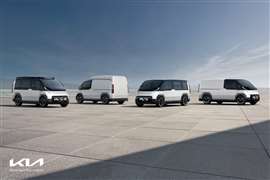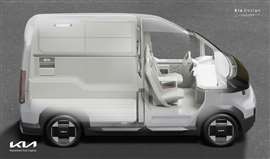Kia unveils PBV commercial vehicles at CES 2024
10 January 2024
 Kia PV5 model range (Photo: Kia)
Kia PV5 model range (Photo: Kia)
South Korean vehicle manufacturer Kia has returned to the CES show after a five-year absence to present its upcoming lineup of electric commercial vehicles.
The Platform Beyond Vehicle (PBV) project will comprise a series of vehicles based on a modular platform/body concept. The vehicles will further benefit from Hyundai Motor Group’s technology covering robotics, software-to-everything (SDx) Advanced Air Mobility and autonomous driving.
“Kia’s PBV business represents our vision of going beyond the traditional concept of automobiles by fulfilling the unmet needs of diverse customers and communities through optimized vehicles and services catering to specific market and business circumstances,” said Ho Sung Song, Kia president and CEO.
According to Kia, the PBV rollout will be divided into three phases. Phase one will see the launch of the Kia PV5, an EV intended for a variety of end-use markets including delivering and utility. Data connectivity will optimise route/delivery info across fleets to improve operational and cost efficiency.
Phase two covers the introduction of the full PBV model lineup, while phase three involves the launch of customisable solutions intended to create a ‘future mobility ecosystem’.
The first PV5 model will later be joined by the PV1, a compact last-mile delivery vehicle, and PV7, intended for longer ranges and improved functionality.
The PBV model range will feature ‘Easy Swap’ technology, which will support a single vehicle being used to address multiple applications. Behind a fixed cab, interchangeable upper bodies can be added and removed using a hybrid electromagnetic and mechanical coupling. With this system, the vehicle could be a taxi during the day, a delivery van at night and a recreational vehicle at weekends.
 PBV concept highlighting ‘Easy Swap’ interchangeable body (photo: Kia)
PBV concept highlighting ‘Easy Swap’ interchangeable body (photo: Kia)
This modularisation is supported by ‘Dynamic Hybrid’ weldless body structure assembly. This allows the length of moveable members to be adjusted according to purpose. Using high-strength steel tubes and engineered polymers part weight has been reduced by a quoted 55% with no loss in rigidity.
Across the vehicles, materials such as bioplastics, post-consumer material, biopaint, recycled PET fabrics and bio-PU foam help to improve related sustainability.
Details released by Kia did not include any powertrain information, although the vehicles can be expected to use battery-electric drives with packs and other hardware in a self-contained sled.
In 2023, Kia started construction of a new, dedicated PBV production plant in Hwaseong, South Korea. The facility is set to start operations in 2025, with an annual capacity of 150,000 units.
STAY CONNECTED




Receive the information you need when you need it through our world-leading magazines, newsletters and daily briefings.
POWER SOURCING GUIDE
The trusted reference and buyer’s guide for 83 years
The original “desktop search engine,” guiding nearly 10,000 users in more than 90 countries it is the primary reference for specifications and details on all the components that go into engine systems.
Visit Now
CONNECT WITH THE TEAM










